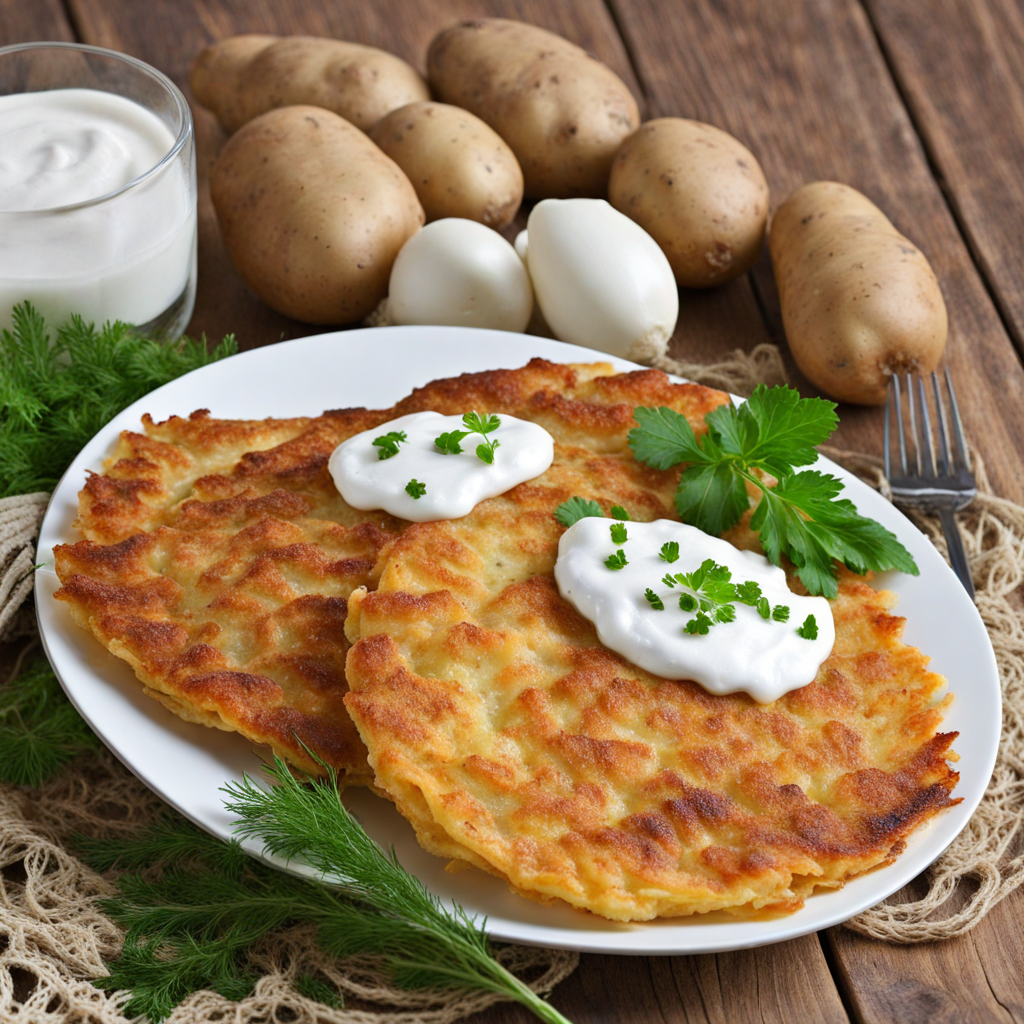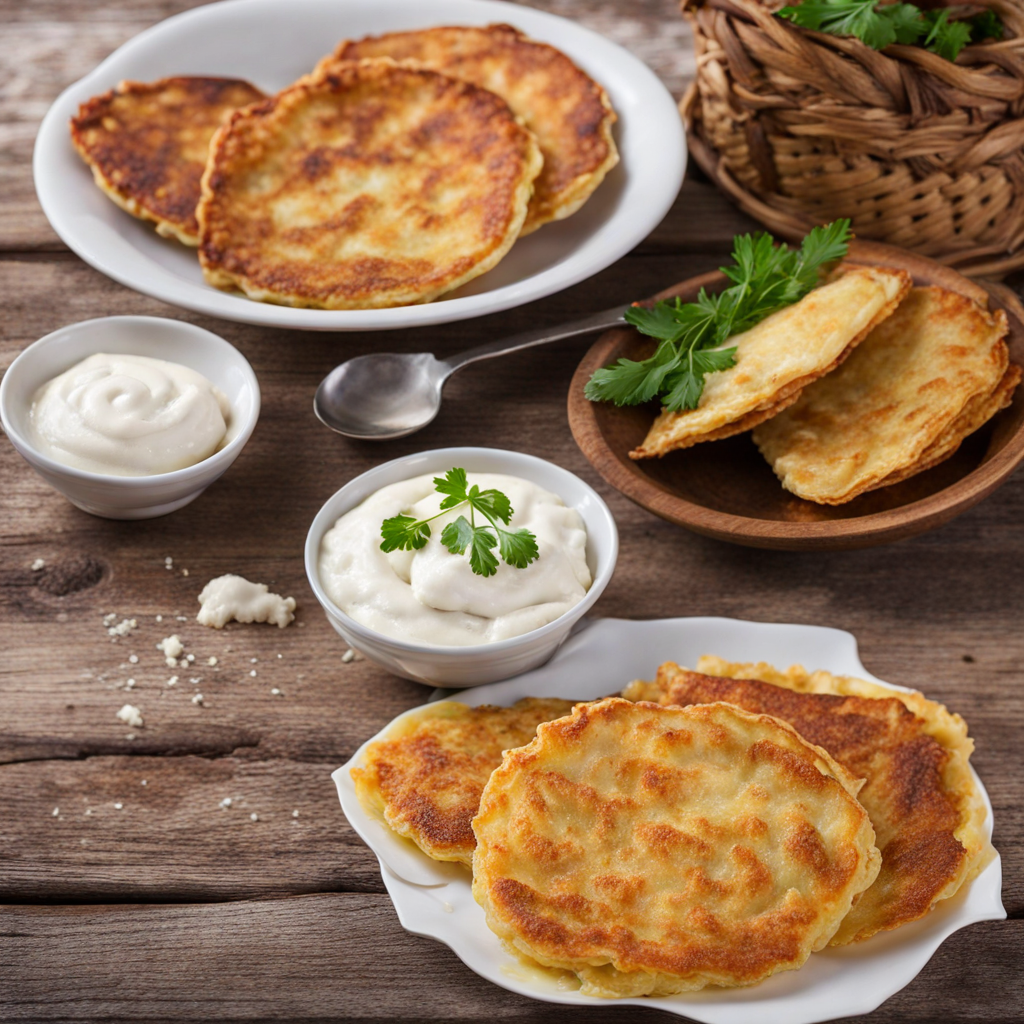Drachena
Drachena is a unique Belarusian dish that captures the essence of Eastern European flavors while offering a delightful twist on traditional comfort food. This hearty dish typically features a base of finely grated potatoes, which are mixed with a blend of onions and spices, then formed into small patties. The mixture is pan-fried to achieve a crispy exterior while the interior remains tender and flavorful. The golden-brown crust adds a satisfying crunch, making each bite a delightful experience for the senses. One of the standout characteristics of Drachena is its versatility. While the classic preparation is simple and rustic, it can be easily customized with various ingredients. Some variations might include the addition of mushrooms, herbs, or cheese, enhancing the dish's flavor profile. Drachena is often served with a dollop of sour cream or a tangy dipping sauce, which complements the savory notes and elevates the overall taste. This dish embodies the spirit of Belarusian cuisine, where humble ingredients are transformed into something truly memorable. In addition to its delicious taste, Drachena is a dish that brings people together. Traditionally enjoyed during family gatherings or festive occasions, it is often shared among loved ones, fostering a sense of community and warmth. The comforting nature of Drachena makes it a perfect meal for chilly evenings, inviting diners to savor each bite and reminisce about shared memories. Whether you're indulging in it for the first time or revisiting a cherished favorite, Drachena is a culinary adventure that promises to leave a lasting impression.
How It Became This Dish
Драчена: A Culinary Journey Through Belarusian History Origin: The Roots of Драчена Драчена, a traditional dish from Belarus, embodies the rich tapestry of the country’s culinary heritage. Its name is derived from the Belarusian verb "драчыць," which means "to beat or to mash," reflecting the method of preparation. The dish is typically made from a mixture of cooked potatoes, flour, and sometimes additional ingredients such as eggs or dairy products, creating a dough-like consistency. It is often served with various toppings, including sour cream, fried onions, or mushrooms. The origins of Драчена can be traced back to the agrarian lifestyle of Belarusian peasants. Potatoes, which became a staple in Belarusian cuisine in the late 18th century, were introduced from South America through Europe. By the 19th century, they had established themselves as a fundamental part of the Belarusian diet. The use of potatoes in Драчена reflects the resourcefulness of the rural population, who utilized locally available ingredients to create hearty and nutritious meals. Cultural Significance: A Symbol of Belarusian Identity Драчена is more than just a dish; it is a symbol of Belarusian identity and cultural heritage. Food in Belarus is deeply intertwined with the nation's history, traditions, and social fabric. Dishes like Драчена are often associated with family gatherings, festive occasions, and communal celebrations, acting as a bridge between generations. In Belarusian culture, food serves as a means of storytelling. Each dish carries with it the memories and experiences of those who prepare and consume it. Драчена, with its humble ingredients and simple preparation, reflects the spirit of Belarusian hospitality and the value placed on togetherness. It is common for families to gather around the table to enjoy a meal of Драчена, fostering bonds that transcend time and space. Additionally, Драчена's significance extends beyond its role in family life. It has become a part of national culinary festivals and cultural events, where it is showcased alongside other traditional dishes. The preparation of Драчена can also be seen as a form of cultural expression, with variations and adaptations reflecting the diverse regional influences across Belarus. Development Over Time: From Rustic Beginnings to Modern Interpretations The evolution of Драчена mirrors the broader changes in Belarusian society and cuisine. Initially, the dish was a simple, rustic meal, primarily consumed by the peasant class. As Belarus underwent significant social and economic transformations, especially during the Soviet era, the culinary landscape began to shift. In the early 20th century, as urbanization increased and the Belarusian populace moved to cities, traditional dishes like Драчена experienced both challenges and adaptations. The availability of ingredients changed, and the dish began to incorporate more diverse elements, including the addition of meat or vegetables. This adaptability allowed Драчена to remain relevant in a rapidly changing society. During the Soviet period, there was a push towards standardization in cuisine, and traditional dishes often lost some of their individual identities. However, in Belarus, the spirit of Драчена endured. Home cooks continued to prepare the dish with love and authenticity, ensuring that it remained a cherished part of the culinary repertoire. With the dissolution of the Soviet Union in 1991, there came a resurgence of interest in national identity and cultural heritage. This revival included a renewed appreciation for traditional foods like Драчена. Chefs and home cooks alike began to experiment with the dish, revitalizing it by incorporating modern cooking techniques and presentation styles while honoring its roots. In contemporary Belarus, Драчена has found its place on restaurant menus, often reimagined with gourmet twists. Chefs may serve it alongside artisanal toppings or pair it with contemporary sauces, elevating this humble dish to new culinary heights. This fusion of tradition and innovation has allowed Драчена to appeal to a broader audience, including younger generations who may not have grown up with it but are eager to explore their cultural heritage through food. Conclusion: The Enduring Legacy of Драчена Драчена serves as a delicious reminder of Belarus's rich history, cultural significance, and the resilience of its people. As a dish born from necessity and resourcefulness, it encapsulates the essence of Belarusian culinary traditions. Through its evolution, Драчена has managed to retain its identity while adapting to the changing landscape of food culture in the country. Today, as Belarus continues to navigate its place in the world, Драчена stands as a testament to the power of food as a connector of people and cultures. It invites us to explore the past while celebrating the present and future of Belarusian cuisine. As families gather to enjoy this beloved dish, they not only nourish their bodies but also forge connections to their heritage, ensuring that the legacy of Драчена endures for generations to come. In a world increasingly dominated by globalization and fast food, Драчена reminds us of the importance of tradition, community, and the stories that bind us—all served on a plate.
You may like
Discover local flavors from Belarus







